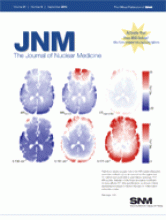TO THE EDITOR: In the December 2009 issue of The Journal of Nuclear Medicine, an invited perspective (1), a study (2), a continuing education paper on ventilation–perfusion (V/Q) SPECT (3), and a lung SPECT/CT image on the front cover can be found. These appeared shortly after the June (4) and July (5) 2009 publication of guidelines by the European Association of Nuclear Medicine detailing V/Q SPECT interpretation criteria. This amount of information seems to indicate that V/Q SPECT has gained much interest.
Several years ago, we compared V/Q SPECT with planar lung scanning in 95 patients who were suspected of recent pulmonary embolism but in whom planar lung scans had been nondiagnostic (6). CT angiography and lower-limb ultrasonography were used as independent reference standards. Using our own V/Q SPECT diagnosis criterion—that even a single subsegmental mismatch defect indicates pulmonary embolism—we found a negative predictive value of 0.94, which is similar to normal D-dimer plasma levels. Sensitivity, specificity, and accuracy were 0.79, 0.83, and 0.80, respectively. All discrepancies with final diagnosis were related to single subsegmental or nonoccluding segmental thrombi.
The tomographic mode enables more precise assessment of the shape of defects, and V/Q SPECT interpretation must overcome the simplistic criterion that a mismatch defect is always related to an underlying thrombus. Because a mismatch defect is not specific to pulmonary embolism, a careful visual analysis is mandatory. At the time that we submitted our manuscript, the topic of V/Q SPECT was considered of low priority and led us to publish our results (6) in a free-access journal (http://www.bentham.org/open/tomij/).
In their study, Gutte et al. (2) use low-dose CT in an elegant way to improve V/Q SPECT performance. There is no doubt that CT will greatly aid in the interpretation of V/Q studies. However, not all nuclear medicine departments have a hybrid γ-camera available to perform V/Q lung SPECT combined with CT.
According to our experience, a precise analysis of V/Q SPECT mismatch defects (location, shape, extent to fissure, presence and location of hot spots when using Technegas [Cyclopharm]) enables a diagnosis in 99% of patients without the use of CT. Illustrations given by Gutte et al. confirm this point.
In daily practice, V/Q lung scanning is used as the first imaging test in a few situations. This trend could be reversed if nuclear medicine physicians would routinely use tomographic instead of planar imaging. The addition of low-dose CT when feasible will probably help to shorten the learning curve for V/Q SPECT abnormalities significantly.
- © 2010 by Society of Nuclear Medicine







